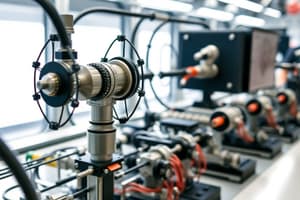Podcast
Questions and Answers
What was the significance of ancient civilization in relation to science and technology?
What was the significance of ancient civilization in relation to science and technology?
- It completely suppressed traditional knowledge.
- It led to the decline of transportation systems.
- It restricted the development of new communication methods.
- It provided a foundation for advances that allowed civilizations to flourish. (correct)
What material was used by ancient Egyptians for writing before papyrus?
What material was used by ancient Egyptians for writing before papyrus?
- Stones and tablets. (correct)
- Clay bricks.
- Animal skins.
- Wooden tablets.
What invention is credited to the Sumerians around the time of ancient civilizations?
What invention is credited to the Sumerians around the time of ancient civilizations?
- The ancient wheel. (correct)
- The steam engine.
- The printing press.
- The integrated circuit.
What does the term 'antecedents of science and technology' refer to?
What does the term 'antecedents of science and technology' refer to?
Which of the following describes the mechanism discovered in Antikythera, Greece?
Which of the following describes the mechanism discovered in Antikythera, Greece?
How did the heavy plough impact European agriculture?
How did the heavy plough impact European agriculture?
What was a key characteristic of advancements during the modern period of science and technology?
What was a key characteristic of advancements during the modern period of science and technology?
What role did animals play in ancient civilization regarding transportation?
What role did animals play in ancient civilization regarding transportation?
What economic benefit did the invention of the heavy plough provide to northern Europe?
What economic benefit did the invention of the heavy plough provide to northern Europe?
Which technology allowed for advancements in warfare including fiery arrows and grenades?
Which technology allowed for advancements in warfare including fiery arrows and grenades?
What was one advantage of using paper money over precious metals?
What was one advantage of using paper money over precious metals?
What was a significant impact of the mechanical clock on society?
What was a significant impact of the mechanical clock on society?
Who is theorized to have invented the spinning wheel?
Who is theorized to have invented the spinning wheel?
Which invention contributed to significant astronomical discoveries such as craters on the moon?
Which invention contributed to significant astronomical discoveries such as craters on the moon?
What did the Jacquard loom simplify in the textile industry?
What did the Jacquard loom simplify in the textile industry?
What feature did Orville and Wilbur Wright discover was crucial for flight?
What feature did Orville and Wilbur Wright discover was crucial for flight?
Flashcards are hidden until you start studying
Study Notes
Historical Antecedents of Science and Technology
- Understanding historical developments informs modern applications and innovations in science and technology.
- Ancient civilizations contributed significantly to scientific and technological advances that supported societal growth.
Ancient Innovations
- The invention of the wheel by the Sumerians revolutionized transportation.
- Ancient Egyptians developed papyrus around 3000 B.C. for writing, replacing stone tablets.
- Egyptian irrigation techniques included hand-operated devices for lifting water, introducing counterweight concepts.
- The Antikythera mechanism, discovered in 1902, functioned as an early astronomical calculator, predicting celestial events.
Major Advancements in the Middle Ages
- The heavy plough transformed European agriculture, increasing crop yields and economic prosperity.
- Chinese alchemists accidentally invented gunpowder around 850 A.D., leading to advancements in warfare technology.
- Paper money emerged in the 17th century, facilitating trade by simplifying transactions compared to coinage.
- The development of mechanical clocks allowed accurate timekeeping, reshaping daily routines and work patterns.
Key Innovations from Different Periods
- The spinning wheel, theorized to be invented by Indians between the 6th and 11th centuries, increased yarn production efficiency dramatically.
- The industrialization period emphasized efficiency in transportation, communication, and production but raised health and environmental concerns.
- Galileo Galilei's telescope magnified 20 times, enabling significant astronomical discoveries.
- Zacharias Janssen invented the microscope in the 1590s, crucial for advancements in medicine, forensics, and genetics.
- Joseph Marie Jacquard's loom simplified textile manufacturing, reducing labor requirements.
- The Wright brothers demonstrated that wing design was essential for flight, paving the way for aviation.
- John Logie Baird created the first mechanical television in the 1920s, which was used for early programming by the BBC.
Studying That Suits You
Use AI to generate personalized quizzes and flashcards to suit your learning preferences.




